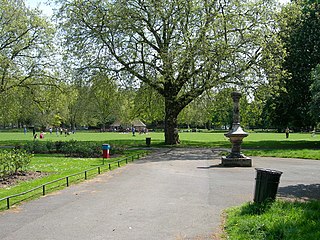
Kennington is a district in south London, England. It is mainly within the London Borough of Lambeth, running along the boundary with the London Borough of Southwark, a boundary which can be discerned from the early medieval period between the Lambeth and St George's parishes of those boroughs respectively. It is located 1.4 miles (2.3 km) south of Charing Cross in Inner London and is identified as a local centre in the London Plan. It was a royal manor in the parish of St Mary, Lambeth in the county of Surrey and was the administrative centre of the parish from 1853. Proximity to central London was key to the development of the area as a residential suburb and it was incorporated into the metropolitan area of London in 1855.

The Oval, currently known for sponsorship reasons as the Kia Oval, is an international cricket ground in Kennington, located in the borough of Lambeth, in south London. The Oval has been the home ground of Surrey County Cricket Club since it was opened in 1845. It was the first ground in England to host international Test cricket in September 1880. The final Test match of the English season is traditionally played there.

Surrey County Cricket Club is a first-class club in county cricket, one of eighteen in the domestic cricket structure of England and Wales. It represents the historic county of Surrey, including areas that now form South London. Teams representing the county are recorded from 1709 onwards; the current club was founded in 1845 and has held first-class status continuously since then. Surrey have played in every top-level domestic cricket competition in England, including every edition of the County Championship.

Wanderers Football Club was an English association football club. It was founded as "Forest Football Club" in 1859 in Leytonstone. In 1864, it changed its name to "Wanderers", a reference to it never having a home stadium, instead playing at various locations in London and the surrounding area. Comprising mainly former pupils of the leading English public schools, Wanderers was one of the dominant teams in the early years of organised football and won the inaugural Football Association Challenge Cup in 1872. The club won the competition five times in total, including three in succession from 1876–78, a feat which has been repeated only once.

Somerset County Cricket Club is one of eighteen first-class county clubs within the domestic cricket structure of England and Wales. It represents the historic county of Somerset. Founded in 1875, Somerset was initially regarded as a minor county until official first-class status was acquired in 1895. Somerset has competed in the County Championship since 1891 and has subsequently played in every top-level domestic cricket competition in England. The club's limited overs team was formerly named the Somerset Sabres, but is now known only as Somerset.
In the years from 1726 to 1750, cricket became an established sport in London and the south-eastern counties of England. In 1726, it was already a thriving sport in the south east and, though limited by the constraints of travel at the time, it was slowly gaining adherents in other parts of England, its growth accelerating with references being found in many counties. Having been essentially a rural pastime for well over a century, cricket became a focus for wealthy patrons and gamblers whose interests funded its growth throughout the 18th century.
The original London Cricket Club was formed in 1722 and was one of the foremost clubs in English cricket over the next four decades, holding important match status. It is closely associated with the Artillery Ground, where it played most of its home matches.

The oldest football clubs trace their origins to the mid-19th century, a period when football evolved from being a casual pastime to an organised mainstream sport.

White Conduit Fields in Islington was an early venue for cricket and several major matches are known to have been played there in the 18th century. It was the original home of the White Conduit Club, forerunner of Marylebone Cricket Club (MCC). Later it was used by The Islington Albion Cricket Club, who played their last game at the ground in 1834. Maps from the time show that the cricket field was a few hundred metres north of the White Conduit House, in the land surrounding the modern Richmond Crescent, and paintings suggest it was also possibly on the adjacent field to the south at the modern Barnard Park.

Kennington Common was a swathe of common land mainly within the London Borough of Lambeth. It was one of the earliest venues for cricket around London, with matches played between 1724 and 1785. The common was also used for public executions, fairs and public gatherings. Important orators spoke there, addressing crowds numbering tens of thousands.
Surrey county cricket teams have been traced back to the 17th century, but Surrey's involvement in cricket goes back much further than that. The first definite mention of cricket anywhere in the world is dated c.1550 in Guildford.
County cricket teams representing Middlesex have been traced back to the 18th century, although for long periods the county was secondary to the London Cricket Club which played at the Artillery Ground. Middlesex teams played at various grounds throughout what is now the Greater London area. Islington and Uxbridge were often used but home matches were also played on Kennington Common and in Berkshire. Middlesex teams were less frequent in the 19th century until 1859 when the Walker family of Southgate became involved in county cricket.
In the 1773 English cricket season, there was a downturn in the fortunes of the Hambledon Club as their Hampshire team lost every match they are known to have played, and some of their defeats were heavy. Their poor results owed much to star bowler Thomas Brett having been injured. Three other county teams were active: Kent, Middlesex and Surrey. Teams called England took part in five matches, all against Hampshire, and won all five.

The 1876 FA Cup final was a football match between Wanderers and Old Etonians on 11 March 1876 at Kennington Oval in London. It was the fifth final of the world's oldest football competition, the Football Association Challenge Cup. Wanderers had won the Cup on two previous occasions. The Etonians were playing in their second consecutive final, having lost in the 1875 final. Both teams had conceded only one goal in the four rounds prior to the final. In the semi-finals Wanderers defeated Swifts and the Etonians beat the 1874 FA Cup winners Oxford University.

Football is a family of team sports that involve, to varying degrees, kicking a ball to score a goal. Unqualified, the word football normally means the form of football that is the most popular where the word is used. Sports commonly called football include association football ; gridiron football ; Australian rules football; rugby union and rugby league; and Gaelic football. These various forms of football share to varying extents common origins and are known as "football codes".
Representing Kingston upon Thames in Surrey, the original Kingston Cricket Club was prominent in the 18th century, taking part in known matches from 1720 to 1767. According to surviving records, it had no specific venue and is known to have played at both Kennington Common and Moulsey Hurst. Kingston teams are recorded, either individually or jointly with other clubs, in eleven known major matches.
In English cricket, the years from 1751 to 1775 are notable for the rise of the Hambledon Club and the continuing spread of the sport across England. The Laws of Cricket underwent a re-codification in 1775, including the introduction of the leg before wicket rule and the addition of the third stump to the wicket.









